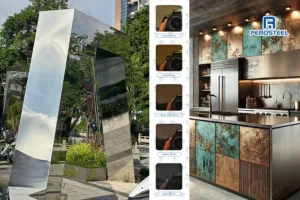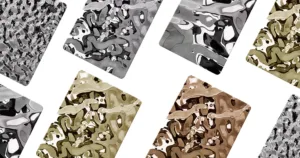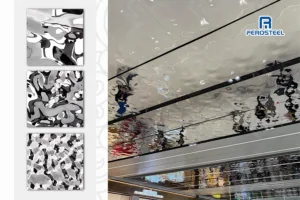Detailed Parameter Comparison: 201 vs 304 Stainless Steel

Based on ASTM, JIS standards, and industry test data:
| Parameter | 201 Stainless Steel | 304 Stainless Steel | Impact on Decorative Use |
|---|---|---|---|
| Chemical Composition | Cr 16-18%, Ni 1-3%, Mn 5.5-7.5%, C≤0.15% | Cr 18-20%, Ni 8-10.5%, C≤0.08% | High Ni in 304 resists tarnish for long-term exposure |
| Density (g/cm³) | 7.93 | 7.93 | Equal weight per volume |
| Tensile Strength (MPa) | 520-880 | 520-750 | 201 better for load-bearing frames/mounts |
| Yield Strength (MPa) | ≥275 | ≥205 | 201 resists deformation under weight |
| Elongation (%) | ≥35 | ≥40 | 304 ideal for complex shapes (e.g., curved sculptures) |
| Hardness (HV) | 180-220 | 170-200 | 201 more scratch-resistant but harder to process |
| Salt Spray Test (hours) | 72-120 (rust spots appear) | 480-720 (no visible corrosion) | 304 mandatory for outdoor installations |
| Thermal Conductivity (W/m·K) | 16.3 | 16.2 | Similar heat resistance |
| Surface Gloss (Gs) | 200-300 (matte) | 300-600 (mirror-polish achievable) | 304 preferred for high-reflectivity designs |
| Magnetic Response | Weakly magnetic (increases after cold work) | Non-magnetic (stable austenitic structure) | 304 safer near electronics |
| Weldability | Requires specialized rods (e.g., ER409) | Compatible with standard rods (e.g., ER308) | 304 welds show uniform aesthetics |
Surface Finish Specifications
1. Brushed Finish (Decorative Applications)
| Parameter | 201 Brushed | 304 Brushed |
|---|---|---|
| Abrasive Grit | 180-240 (coarse texture hides defects) | 320-400 (fine hairline patterns) |
| Texture Depth (μm) | 15-25 | 8-15 |
| Fingerprint Resistance | ★★☆ (requires anti-fouling coating) | ★★★☆ (natural oxidation resistance) |
2. Bead Blast Finish (Aesthetic & Functional)
| Parameter | 201 Bead Blast | 304 Bead Blast |
|---|---|---|
| Abrasive Material | Glass beads (low cost) | Zirconia sand (high durability) |
| Roughness Ra (μm) | 1.6-3.2 | 0.8-1.6 |
| Matte Appearance | Pronounced grain | Smooth uniformity |
Application Scenarios & Case Studies

1. Wall/Ceiling Cladding
- Dry Indoor: 201 + Random Brushing (40% cost saving, hides seams)
- Humid/Outdoor: 304 + Bead Blast + PVD Coating (e.g., black titanium, rose gold)
2. Furniture/Artwork
- Structural Frames: 201 Square Tubes + Bead Blast (hidden welds, high rigidity)
- Decorative Panels: 304 Thin Sheets (0.8mm) + Mirror Polish/Etching
3. Lighting Design
- LED Baseplates: 201 Brushed (diffuses light evenly)
- Spotlight Reflectors: 304 Mirror Finish (reflectivity >90%, requires frequent cleaning)
Industry Test Data
- 201 Brushed Outdoor Test (Guangzhou, rainy season):
- 3 months: Surface rust spots observed
- 6 months: Seam corrosion requires refinishing
- 304 Bead Blast Salt Spray Test:
- 500 hours: No visible changes (ASTM B117 compliant)
- 1000 hours: Slight edge graying, no structural impact

Purchasing Checklist
- Material Verification:
- Use 304 testing solution (turns red after >5 minutes; 201 reacts in <1 minute)
- Request mill test reports (GB/T 3280-2015 compliant)
- Thickness Tolerance:
- Standard: ±0.02mm for decorative sheets; reject products exceeding ±0.1mm
- Surface Finish Traps:
- Cheap 201 “mirror” finishes are often adhesive films (peels within 3 months)
Cost-Saving Strategies
- Hybrid Material Use: Visible areas (304) + hidden supports (201)
- Thickness Optimization: 0.6mm 201 for non-structural elements
- Bulk Customization: Standardize surface finishes to reduce processing fees
Emerging Trends
- Flexible Thin Stainless: 0.3mm sheets for curved surfaces
- Smart Surfaces: 304 bead blast + conductive coatings (touch-sensitive lighting)
- Bio-mimicry Textures: Laser-engraved wood/stone patterns (eco-friendly alternative)
Frequently Asked Questions (FAQs)
Can 201 stainless steel undergo a brushed finish?
Yes, but prolonged exposure to humid environments may cause rust spots. We recommend pairing it with an anti-rust coating for enhanced durability.
Does bead blast treatment reduce stainless steel’s corrosion resistance?
No, the corrosion resistance remains unaffected. However, the increased surface roughness may trap dust more easily, requiring regular cleaning and maintenance.
How to visually distinguish 201 vs 304 stainless steel?
Professional verification requires a testing reagent (e.g., molybdenum detection solution). Visually, 304 typically has a brighter, shinier appearance, while 201 exhibits a dull grayish tone.



